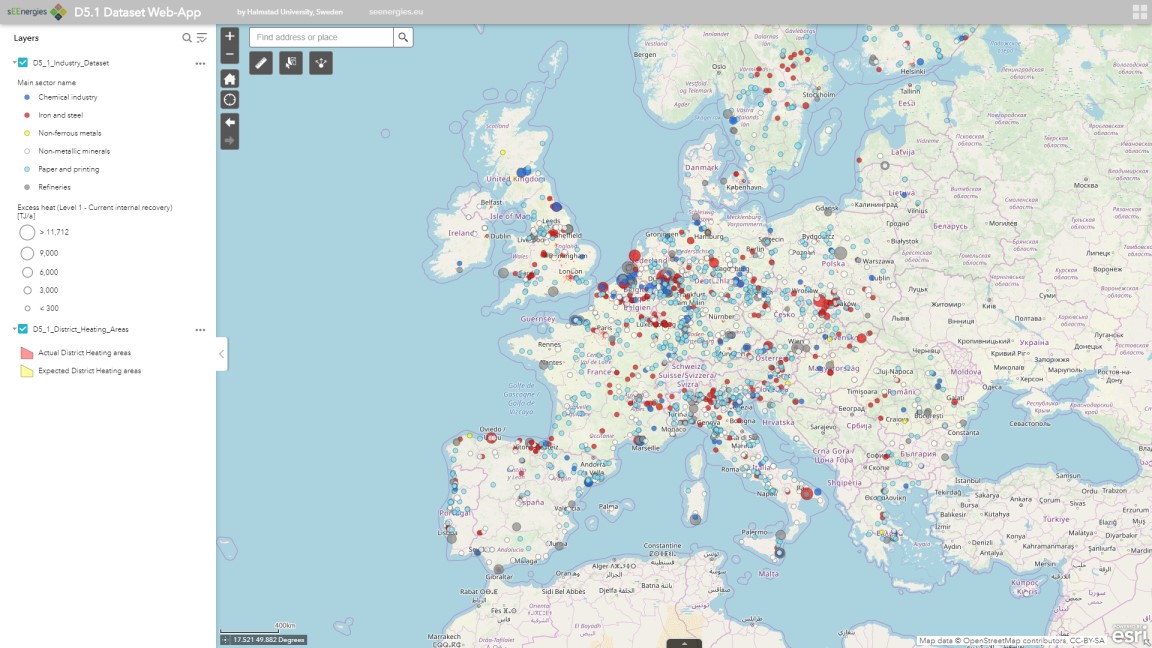
03 Jun Excess heat potentials of industrial sites in Europe
Documentation on excess heat potentials of industrial sites including open data file with selected potentials
Facilities of energy-intensive industries including those for the production of steel, cement, paper, glass, chemicals and others are spread across Europe. The combination of high flue gas temperatures, continuous operation and highly concentrated point sources make the excess heat from such industrial plants a very attractive source for district heating. Despite this, excess heat sources from industry are currently only rarely exploited and major potentials are being wasted.
Here, we aim to contribute by providing the most detailed, comprehensive assessment of the excess heat potentials available for Europe. More specifically, we aim to analyse the available excess heat from heavy industry in Europe and assess its suitability for use in district heating systems. Our approach uses GIS-based mapping of 1608 industrial sites in Europe combined with a process-specific assessment of their excess heat potential. The heat sources are then matched with data on heat demand density and existing as well as potential district heating networks. The scope of this analysis covers the major industrial excess heat sources (large heavy industry facilities) and the most important excess heat streams: flue gases.
Our results show a total potential of 425 PJ of excess heat available at a temperature of 95°C, with 960 PJ available at a lower temperature (25°C). This equals about 4% and 9% of total industrial final energy demand in 2015, respectively.
Matching this potential with a GIS analysis of heat demand densities and current district heating systems reveals that 151 PJ of excess heat could be used within a 10km range at a temperature of 95°C, which is compatible with most existing district heating systems. As district heat today has a total final energy consumption of 1,945 PJ, this means that about 8% of district heating in the EU28 could be supplied by excess heat sources from energy-intensive industries.
While this is already a substantial potential, many excess heat sources remain untapped, particularly in countries with low district heating use. We therefore projected future district heating systems based on a GIS analysis of heat demand densities for all EU28 countries. The results indicate that district heating systems would be economically viable in all urban areas in Europe and could cover about 65% of heat demand in buildings in the residential and service sectors. This represents an enormous increase compared to today’s use of district heating. If district heating networks were expanded, they could use almost all the available excess heat from the industrial sites analysed. 98% of these are within 10km, allowing the exploitation of 415 PJ of heat at 95°C.
In the future, low-temperature district heating systems, often referred to as 4th generation district heating, are expected to diffuse further, which will increase the amount of excess heat available. For example, at a temperature of 25°C, the exploitable excess heat potentials will more than double from 415 PJ (95°C) to 940 PJ (25°C). This low-temperature heat could either be used in cold district heating systems with decentralised heat pumps, or in centralised large-scale heat pumps to supply district heating systems at higher temperatures.
To summarize, our analysis reveals a significant potential of mostly untapped excess heat from energy-intensive industries that could be used in district heating systems as well as a huge potential to increase the use of district heating systems in Europe. Combining excess heat sources and the deployment of district heating systems should therefore be a central element in the transition towards a sustainable and CO2-neutral heating and cooling sector in Europe. However, the analysis also shows that industrial excess heat alone will not be sufficient, and the major heat source for district heating will need to come from renewable energy sources (locally, this might be different in highly industrialised areas).
It should be emphasized that the bottom-up approach used inherently underestimates the available potentials, because it focuses on the largest point sources, major processes and flue gases as the most attractive excess heat streams. Although the analysis covers the most attractive potentials, including additional excess heat sources would increase the potentials available, particularly at lower temperatures. However, it should also be considered that some of the excess heat might be used via internal heat recovery before it is delivered to a district heating system.
Available results:
The main report is available for download here.
The two major outputs from this work, the georeferenced industrial sites dataset and the district heating areas dataset (expected and actual), are published as web map layers at the sEEnergies D5.1 Web-App hosted by Europa-Universität Flensburg:
Figure 1 provides a screenshot of both layers in zoomed-out view at this browser-based Web-App.
Both datasets are further available for download at the sEEnergies Open Data hub:
At this site, the datasets are visible on a map but also available for download in geospatial and tabular form. The datasets are published under the Creative Commons CC BY 4.0 license.

